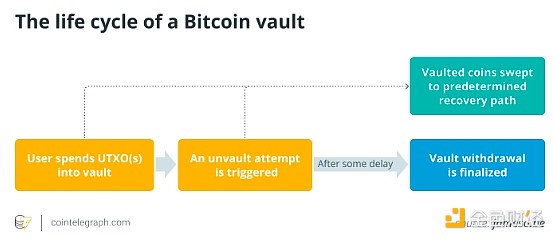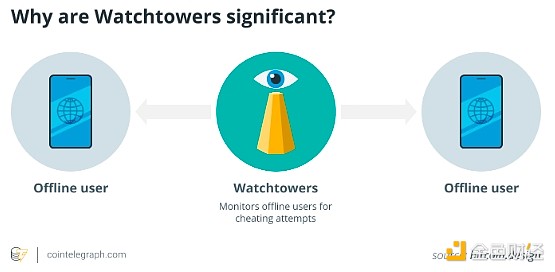Author: Onkar Singh, CoinTelegraph; Compiler: Wuzhu, Golden Finance
1. What is OP_VAULT?
OP_VAULT is a feature that adds extra security to Bitcoin, helping to prevent it from being stolen or accessed without authorization.
The decentralized nature of Bitcoin has revolutionized the digital economy. Still, as its use grows, so does the need for enhanced security. That's where OP_VAULT comes in, an innovative feature that introduces a mechanism called "contracts" to provide greater security and flexibility.
In Bitcoin, "OP" stands for "operation code" or "code." An opcode is part of the Bitcoin scripting language and represents a single command or instruction that tells the blockchain how to process a transaction. These codes enable Bitcoin scripts to add functionality and enforce rules. For example, OP_CHECKSIG verifies a digital signature, while OP_RETURN allows data to be embedded on the blockchain. The "OP_" prefix is a standard prefix for these commands, making it easy to quickly identify them in a script.
But what are covenants in Bitcoin?
Covenants in Bitcoin are rules or conditions that dictate how funds can be spent. Beyond the standard one-time authorization to spend a token, covenants add ongoing constraints, creating a structure where specific actions must be followed even across multiple transactions. This means that covenants ensure that tokens remain protected by certain rules over time, thereby enhancing security and enabling unique spending conditions.
So where do vaults fit in here?
Vaults are a practical form of covenant that focuses on simplifying everyday use while adding extra safeguards to prevent unauthorized spending.
Here’s how vaults work:
Setting up a vault: To ensure funds are safe, users place funds into a vault and set up monitoring processes to watch the blockchain.
The process of withdrawing funds: If an attempt is made to withdraw funds (called an “exit”), a waiting period will occur, which gives the vault owner time to respond.
Callback mechanism:In the event of an unexpected withdrawal request, the owner can initiate a "callback" to pull the funds back to a safe account to prevent unauthorized spending. A callback is a security mechanism that allows users to recover or "call back" funds when they are in danger of unauthorized spending.
Note: In Bitcoin, Watchtower is a monitoring system designed to help protect users' funds, especially when it comes to advanced features such as vaults or payment channels (such as those used in the Lightning Network). Watchtowers continuously monitor the blockchain for any suspicious or unauthorized activity involving user funds and can take action if such activity is detected.
Who introduced OP_VAULT and the development through BIP
OP_VAULT is part of a broader trend in Bitcoin to introduce more advanced features through Bitcoin Improvement Proposals (BIPs), which are formal documents used to propose changes or improvements to the Bitcoin network.
OP_Vault was proposed in 2023 by Bitcoin developer and researcher James O’Beirne, as detailed in BIP 345. The proposal aims to create a structured method for securely storing Bitcoin using vaults. O’Beirne’s work on OP_Vault builds on earlier advances such as OP_CHECKTEMPLATEVERIFY (CTV) and has played an important role in shaping Bitcoin’s contractual framework.
Notably, BIP-119, proposed by Jeremy Rubin (Bitcoin developer, researcher, and advocate), introduced OP_CHECKTEMPLATEVERIFY, which laid the foundation for OP_Vault by allowing secure vault construction without the need for complex key management.
III. How does OP_Vault work?
Features such as OP_CHECKTEMPLATEVERIFY (CTV) make it possible to use vaults without complex setups such as storing pre-signed transactions or managing temporary keys.
With CTV, the conditions and potential transactions of a vault are pre-calculated and “locked” on the blockchain, making it easy to monitor and manage funds without the need for additional storage of sensitive data. This significantly reduces the risks associated with losing critical information or operational complexity.
Key Components of OP_Vault
An OP_Vault setup has three basic elements:
Recovery Path:This is a backup address to which funds can be directed when needed, usually protected by strict conditions such as offline or multi-signature wallets. All vaults that share the same recovery path can be managed in batches, which is very useful when dealing with multiple vaults.
Cancel Vault Key:This key allows the process of cancelling a vault (attempting to spend from the vault) to be started. Still, even if an attacker gains access to this key, they will not be able to steal funds immediately, as outflows can be stopped and redirected to a recovery address if detected in time.
Outbound destination:This is where the funds will eventually go after the outbound delay. The destination is flexible and can include a variety of destinations (including amounts), support partial cancellation of the vault, and even create new vaults.
Fourth, how to use Bitcoin Vault
Create a vault to safely store Bitcoin, deposit funds, set recovery options and monitor with Watchtower; if necessary, trigger a callback to recover funds and keep them safe.
Create a vault:Use a wallet or service that supports Bitcoin vaults to create a vault address configured with a contract. This is where your Bitcoin will be stored safely.
Deposit Bitcoin into a vault:Sending Bitcoin to a vault address is similar to sending Bitcoin to a regular wallet address. Vaults ensure additional security through specialized rules.
Set Recovery and Security Options:Choose a Recovery Address (secure backup location) for your Bitcoin. This can be an offline wallet or a multi-signature setup for extra protection. Alternatively, configure a Watchtower to monitor your vault for unauthorized access attempts.
Withdraw from your vault:To access your funds you must go through a process of withdrawing your vault, which often involves delays to ensure security and allow time for intervention if necessary.

If something goes wrong and you need to recover your Bitcoin from the vault, the process is simple but requires a few extra steps:
Detect Unauthorized Activity:Watchtower or you notice if someone is trying to access your Bitcoin without permission.
Trigger a Callback:Use the Callback feature to send funds to a secure recovery address. Watchtower can do this for you automatically, or you can do it manually by broadcasting a Callback transaction using your wallet or service.
Bitcoin is safe again: Once the call back is triggered, the funds are transferred to your recovery address, ensuring they are protected.

V. Advantages and limitations of OP_Vault
OP_Vault improves Bitcoin security by simplifying key storage and enabling bulk recovery management, although it limits the flexibility of fixed destinations and lacks bulk unstorage capabilities.
The OP_Vault approach offers several advantages for Bitcoin security:
No need for complex key storage:It reduces reliance on ephemeral keys and large amounts of transaction storage, as CTV handles most of the work.
Efficient fund management:Supports batch operation recovery, making it easier to manage multiple vaults simultaneously.
Defense against 51% attacks:Despite the strength of the Bitcoin network, high-value holders (whales) remain vulnerable to social engineering and targeted attacks. OP_VAULT aims to enhance security by introducing multi-signature requirements or other complex conditions to make it more difficult for malicious actors to access funds.
However, OP_Vault also has limitations:
Fixed destination:Once a destination is set, it cannot be changed, which limits flexibility.
Fungibility issues:Bitcoin vaults, especially those with advanced features such as OP_VAULT, may lose fungibility if they are linked to suspicious transactions or blacklisted addresses. This may reduce the value and liquidity of specific tokens as they may be rejected by exchanges or other participants.
No support for bulk unstorage:Combined unstorage is not currently supported, which may limit response options in high-risk situations.
Physical attacks:Physical theft of a hardware wallet or other key storage device associated with a Bitcoin vault may result in a loss of access to funds.
When will OP_VAULT be implemented on Bitcoin?
The implementation timeline for OP_VAULT depends on the progress of related BIPs, specifically BIP-119, which introduces the concept of the OP_CHECKTEMPLATEVERIFY (CTV) contract.
OP_VAULT is still in the proposal stage and does not yet have an official release date. Bitcoin’s development process is conservative, with changes subject to rigorous testing, peer review, and community consensus.
To further improve the security of user funds, future updates may include additional features such as location-based transaction limits, biometric access, and even AI-driven monitoring for suspicious activity.
If OP_VAULT gains widespread acceptance, it could be included in a future Bitcoin upgrade, but this could take months or years as the Bitcoin network prioritizes stability and security. As such, users should stay tuned for updates on development.
 Jixu
Jixu
 Jixu
Jixu Jasper
Jasper Clement
Clement Catherine
Catherine Hui Xin
Hui Xin Clement
Clement Brian
Brian Aaron
Aaron Jixu
Jixu Jasper
Jasper